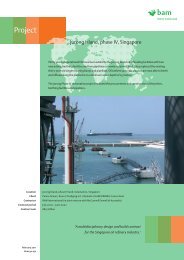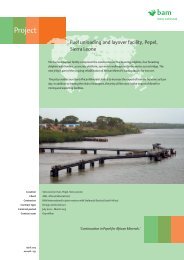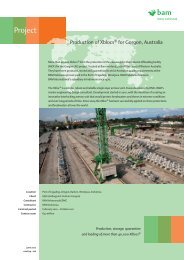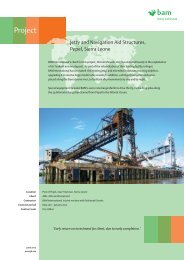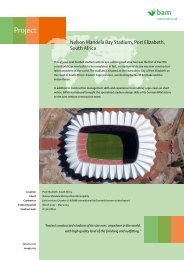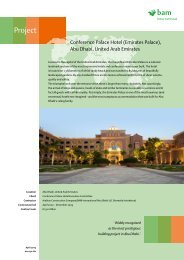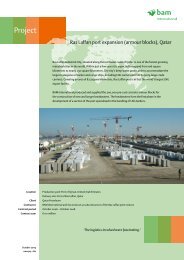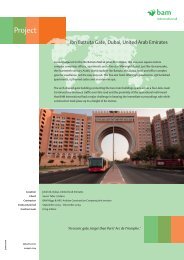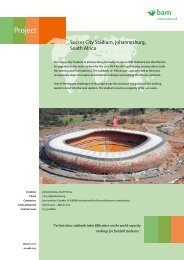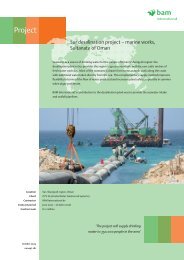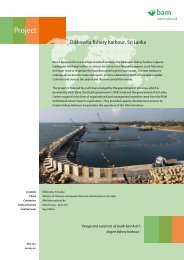The Chesapeake Bay Bridge Parallel Crossing ... - BAM International
The Chesapeake Bay Bridge Parallel Crossing ... - BAM International
The Chesapeake Bay Bridge Parallel Crossing ... - BAM International
You also want an ePaper? Increase the reach of your titles
YUMPU automatically turns print PDFs into web optimized ePapers that Google loves.
Project<br />
<strong>The</strong> <strong>Chesapeake</strong> <strong>Bay</strong> <strong>Bridge</strong> <strong>Parallel</strong> <strong>Crossing</strong>,<br />
Virginia, United States of America<br />
This 20-mile-long bridge tunnel complex connects Virginia Beach with the eastern shore of Virginia.<br />
It is located at the mouth of the <strong>Chesapeake</strong> <strong>Bay</strong> near the Atlantic Ocean, an area exposed to severe<br />
weather and ocean conditions. <strong>The</strong> original facility, which includes two tunnels, was built in the<br />
1960s and was considered one of the engineering marvels of the world. This was not only because<br />
of its length, but also due to the challenging environment for its construction.<br />
<strong>The</strong> parallel crossing was built to increase safety by separating traffic in opposite directions. It also<br />
would allow major repair work to the old bridge upon opening for traffic of the new spans as was<br />
part of the contract. Construction started in September 1995 and the project was handed over<br />
and accepted by the client on the contractual completion date of 1 July 1999.<br />
Location<br />
Client<br />
Contractor<br />
Contract period<br />
Contract sum<br />
Virginia Beach and Northampton County, Virginia, USA<br />
<strong>Chesapeake</strong> <strong>Bay</strong> <strong>Bridge</strong> and Tunnel District<br />
PLC/Hardaway/<strong>BAM</strong> <strong>International</strong> joint venture<br />
May 1995 - July 1999<br />
$ 223 million<br />
'A challenging project in ocean conditions that was<br />
enabled by application of the specialised marine equipment<br />
and skills of <strong>BAM</strong> <strong>International</strong>.'<br />
June 2010<br />
624066-144
Toll booths<br />
Scope of work<br />
<strong>The</strong> 12-mile low-level trestle forms the main component of the<br />
project. <strong>The</strong> typical 100-feet spans consist of three precast and<br />
prestressed modular deck units, which are connected by transverse<br />
post-tensioning. <strong>The</strong> spans are supported by a bent typically<br />
consisting of three 54-inches cylinder piles and a precast bent cap.<br />
Another major part of the project was the high level North Channel<br />
<strong>Bridge</strong>, including a navigation span and large water line footings.<br />
Its superstructure consists of steel plate girders with a cast-in-place<br />
deck.<br />
Road work, electric and mechanical installations were mainly<br />
performed by subcontractors to the joint venture and formed an<br />
essential portion of this large turnkey project.<br />
Precast yard<br />
Most of precast manufacturing for the bridge was performed in<br />
the joint venture's own precast yard, which was mobilised on a<br />
27-acre piece of waterfront property in Virginia Beach.<br />
Overview of the bridge serial production<br />
North Channel <strong>Bridge</strong><br />
Construction of the North Channel <strong>Bridge</strong> included driving<br />
cylinder piles for the large footings. <strong>The</strong> footings were made by<br />
placing a precast slab including wall form as one unit on the<br />
piles. Following the placement of these 'bath tubs', the structural<br />
concrete was then placed to form the monolithic footing, which<br />
measured up to 30x70 feet. This concrete was placed by<br />
shuttling ready mixed concrete from shore.<br />
<strong>The</strong> IB-909 jack-up barge placed most of the 'bath tubs', while<br />
the remainder of the substructure was built using crane barges.<br />
<strong>The</strong> steel erection involved the setting of pre-assembled girders<br />
and was again done mainly by the IB-909, in view of the<br />
exposure to weather and seas in this area. A cast-in-place deck<br />
was placed 'over-the-top', completely independent of waterbased<br />
equipment.<br />
Placing the steel girders<br />
Slope protection<br />
<strong>BAM</strong> <strong>International</strong> bv<br />
P.O. Box 414<br />
H.J. Nederhorststraat 1<br />
2800 AK Gouda<br />
<strong>The</strong> Netherlands<br />
T +31 (0)182 59 06 30<br />
F +31 (0)182 59 08 70<br />
E info@baminternational.com<br />
I www.baminternational.com



